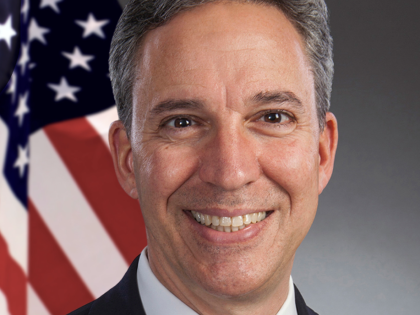
October Is Breast Cancer Awareness Month
Jack M. Martins
October 19, 2011
-
ISSUE:
- Health

Few things in life are more frightening, confusing or devastating than a diagnosis of cancer. The word alone is enough to send shivers down the spine of most people, especially when it strikes close to home, either in yourself or a loved one. Yet the outlook for people with cancer is often better than ever before.
The Senate is committed to providing important information about breast cancer, along with pertinent web sites and phone numbers where you can gather additional reference material as well.
As is often the case with chronic illness, education is the key to early detection in the fi ght against cancer. By recognizing the symptoms of breast cancer, even when some may seem mild or inconsequential, women can seek medical attention early, if needed, thereby increasing survival rates.
________________________________________________________
According to the American Cancer Society, breast cancer is the most common cancer among women in the United States, other than skin cancer. It is the second leading cause of cancer death in women, after lung cancer. The good news is that the survival rate, when detected early, is 100%. In the United States alone, there are over 2.5 million breast cancer survivors which can be attributed to earlier detection and better treatment. There is no sure way to prevent breast cancer but there are things that women can do to reduce their risks of getting the disease.
RISK FACTORS FOR BREAST CANCER
The exact causes of breast cancer are unknown, but research has shown that women with certain risk factors are more likely than others to develop breast cancer. The risk factors for breast cancer include, but are not limited to, the following:
AGE: The chance of getting breast cancer goes up as a woman gets older. Most cases of breast cancer occur in women over 60.
PERSONAL HISTORY OF BREAST CANCER: A woman who had breast cancer in one breast has an increased risk of getting cancer in her other breast.
FAMILY HISTORY: A woman’s risk of breast cancer is higher if her mother, sister, or daughter had breast cancer. The risk is higher if her family member got breast cancer before age 40.
REPRODUCTIVE AND MENSTRUAL HISTORY: The older a woman is when she has her fi rst child, the greater her chance of breast cancer, and/or beginning fi rst menstrual period before age 12, beginning menopause after age 55, never giving birth, and/or taking menopausal hormone replacement therapy with estrogen plus progestin.
RADIATION THERAPY: If someone has had radiation to the chest before age 30, including women treated with radiation for Hodgkin’s lymphoma, tuberculosis or scoliosis, this can also pose a threat.
MAMMOGRAPHY
A mammogram is an X-ray of the breast tissue. A “screening” mammogram is one that is done when you do not have any symptoms. A mammogram can fi nd a lump up to two years before it would be large enough to be felt. It is important to know that a mammogram, like most medical tests, is not fool-proof. Therefore, it is important to still perform breast self-examination as well as obtain regular mammograms.
New York State and Federal Law require mammogram providers to meet certain standards. To ensure your mammogram is of good quality and interpreted properly, you should:
•Ask when the facility was last inspected by the New York State or New York City Department of Health.
•Choose a facility that performs a high number of mammograms.
•Make sure the doctor who reads the mammogram has a lot of experience with mammography.
•Have the results of the mammogram sent in writing to your doctor.
The American Cancer Society recommends that every woman have a baseline mammogram by age 40, and a screening mammography every year thereafter. However, every woman should consult her doctor about this issue.
INSURANCE COVERAGE FOR MAMMOGRAPHY
New York State law requires most insurance companies to pay for mammograms. The Women’s Health Law requires insurance companies to pay for an initial baseline mammogram for women between the ages of 35 and 39, and annual mammograms for women age 40 and up, or more frequently upon a doctor’s recommendation. Women who have diffi culty meeting costs of breast exams can check their eligibility for free screenings through the Cancer Services Program Partnerships. This Program provides low-income, uninsured or under-insured women with annual comprehensive screening examinations and follow-up services. For more information, visit the State Health Department on the Internet at www.nyhealth.gov.
Medicaid is both a state and federally administered program. If you receive health benefi ts under the State’s Medicaid program, Medicaid does pay for the screening mammograms.
Medicare is a federally operated health insurance program for persons 65 years of age or older and persons with certain disabilities. All women with Medicare age 40 and older can get a screening mammogram every 12 months. Medicare also pays for one baseline mammogram for women with Medicare between ages 35 and 39.
For more information visit: http://www.medicare.gov/,
or call the Social Security Administration at 1-800-MEDICARE.
PHYSICAL BREAST EXAMINATION
If you are over age 40, you should have a physical breast exam performed every year by your physician or other trained health professional. If you are between the ages of 20 and 40, this should be done once every three years. All women should do monthly breast self-examinations (BSE). Ask your health professional to instruct you and provide you with information on BSE.
Share this Article or Press Release
Newsroom
Go to NewsroomSenator Martins' Toy Drive 2025
November 10, 2025

Fill a Backpack Program
June 10, 2025


